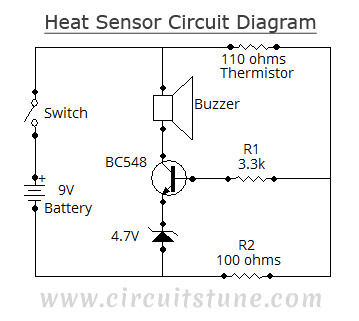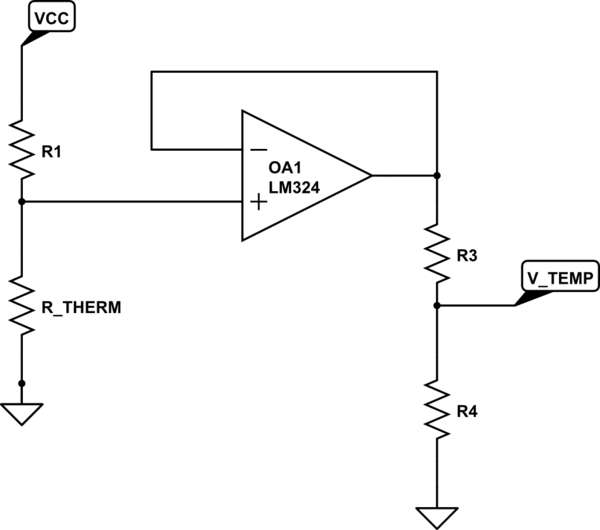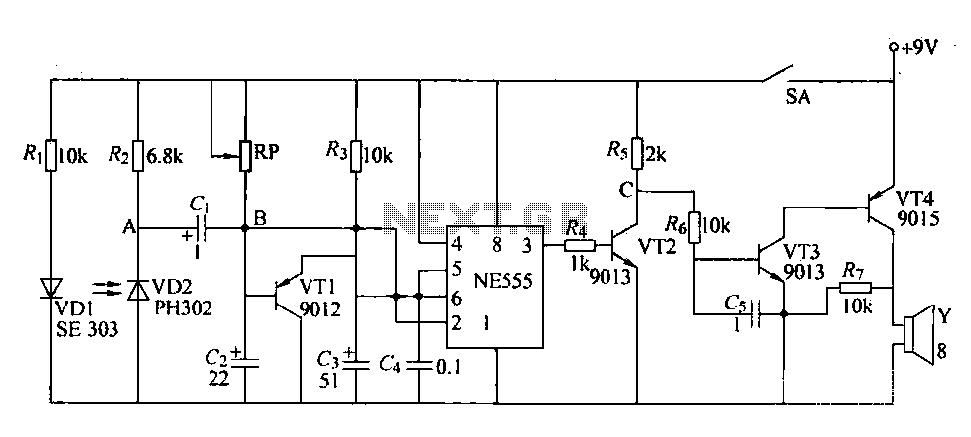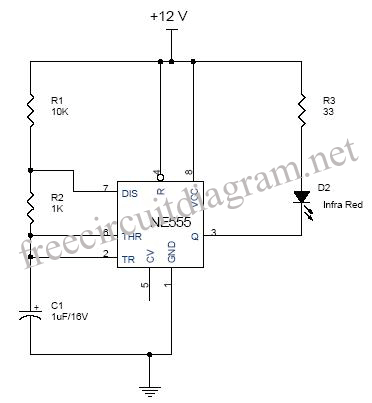
Heat Sensor

This simple heat sensor circuit can detect heat from various electronic devices such as computers and amplifiers, generating a warning alarm when overheating occurs. It can also sense heat from the environment, but it is primarily designed for use in electronic devices to protect them from overheating. In this circuit, a thermistor serves as the heat sensor. This thermal measurement device has multiple applications, including functioning as a temperature sensor or heat sensor. The thermistor utilized in this circuit is of the NTC (Negative Temperature Coefficient) type, meaning that its resistance decreases as the temperature increases. Therefore, the resistance of an NTC thermistor is inversely related to temperature. The circuit employs a BC548 transistor, which is a TO-92 type NPN transistor; alternatives such as the 2N2222, BC238, BC168, and BC183 can also be used, as they share similar characteristics.
The heat sensor circuit operates by monitoring the temperature of the environment or specific electronic devices. When the temperature rises beyond a predetermined threshold, the NTC thermistor's resistance decreases, causing a change in the voltage across it. This change is sensed by the NPN transistor (BC548), which acts as a switch. When the thermistor's resistance drops sufficiently, the transistor is activated, allowing current to flow through the alarm indicator (such as an LED or a buzzer), thereby alerting the user to the overheating condition.
The circuit can be powered by a standard DC power supply, typically ranging from 5V to 12V, depending on the specific components used. The thermistor should be placed in proximity to the heat source for effective monitoring, and the transistor should be adequately heat-sinked if necessary to prevent thermal runaway during operation. Additionally, the values of any resistors in the circuit should be chosen based on the desired sensitivity and response time of the heat detection.
This heat sensor circuit is particularly useful in applications where electronic devices are prone to overheating, providing an essential safety feature to prevent damage and ensure operational reliability. Proper calibration and testing of the circuit are recommended to ensure accurate temperature sensing and timely alarm activation.This simple heat sensor circuit could senses heat from various electronics device like computer, amplifier etc. and generate warning alarm. It could senses heat from environment also, but here I mention electronics device because it is being using mostly in electronic device to protect them from overheat.
As it is a heat sensor circuit, here a thermistor is used as a heat sensor. It is a thermal measurement device and has a variety of usages including temperature sensor/ heat sensor. The thermistor used in this circuit is a NTC (Negative Temperature Coefficient) type thermistor. When temperature increases, its resistance goes decrease. Therefore, NTC thermistor`s resistances are inverse of temperature. BC548: BC548 is a TO-92 type NPN transistor, as its alternative you can use 2N2222, BC238, BC548, BC168, BC183 etc.
they all have almost same characteristic. 🔗 External reference
The heat sensor circuit operates by monitoring the temperature of the environment or specific electronic devices. When the temperature rises beyond a predetermined threshold, the NTC thermistor's resistance decreases, causing a change in the voltage across it. This change is sensed by the NPN transistor (BC548), which acts as a switch. When the thermistor's resistance drops sufficiently, the transistor is activated, allowing current to flow through the alarm indicator (such as an LED or a buzzer), thereby alerting the user to the overheating condition.
The circuit can be powered by a standard DC power supply, typically ranging from 5V to 12V, depending on the specific components used. The thermistor should be placed in proximity to the heat source for effective monitoring, and the transistor should be adequately heat-sinked if necessary to prevent thermal runaway during operation. Additionally, the values of any resistors in the circuit should be chosen based on the desired sensitivity and response time of the heat detection.
This heat sensor circuit is particularly useful in applications where electronic devices are prone to overheating, providing an essential safety feature to prevent damage and ensure operational reliability. Proper calibration and testing of the circuit are recommended to ensure accurate temperature sensing and timely alarm activation.This simple heat sensor circuit could senses heat from various electronics device like computer, amplifier etc. and generate warning alarm. It could senses heat from environment also, but here I mention electronics device because it is being using mostly in electronic device to protect them from overheat.
As it is a heat sensor circuit, here a thermistor is used as a heat sensor. It is a thermal measurement device and has a variety of usages including temperature sensor/ heat sensor. The thermistor used in this circuit is a NTC (Negative Temperature Coefficient) type thermistor. When temperature increases, its resistance goes decrease. Therefore, NTC thermistor`s resistances are inverse of temperature. BC548: BC548 is a TO-92 type NPN transistor, as its alternative you can use 2N2222, BC238, BC548, BC168, BC183 etc.
they all have almost same characteristic. 🔗 External reference





